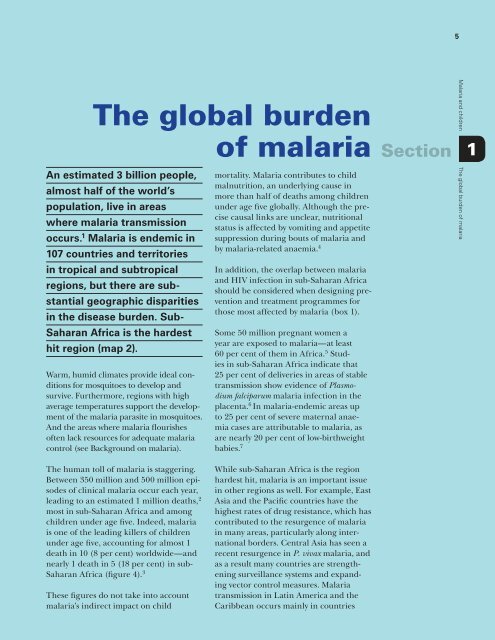Malaria and children: Progress in intervention coverage - Unicef
Malaria and children: Progress in intervention coverage - Unicef
Malaria and children: Progress in intervention coverage - Unicef
You also want an ePaper? Increase the reach of your titles
YUMPU automatically turns print PDFs into web optimized ePapers that Google loves.
5<br />
The global burden<br />
of malaria<br />
Section<br />
<strong>Malaria</strong> <strong>and</strong> <strong>children</strong><br />
1<br />
An estimated 3 billion people,<br />
almost half of the world’s<br />
population, live <strong>in</strong> areas<br />
where malaria transmission<br />
occurs. 1 <strong>Malaria</strong> is endemic <strong>in</strong><br />
107 countries <strong>and</strong> territories<br />
<strong>in</strong> tropical <strong>and</strong> subtropical<br />
regions, but there are substantial<br />
geographic disparities<br />
<strong>in</strong> the disease burden. Sub-<br />
Saharan Africa is the hardest<br />
hit region (map 2).<br />
Warm, humid climates provide ideal conditions<br />
for mosquitoes to develop <strong>and</strong><br />
survive. Furthermore, regions with high<br />
average temperatures support the development<br />
of the malaria parasite <strong>in</strong> mosquitoes.<br />
And the areas where malaria flourishes<br />
often lack resources for adequate malaria<br />
control (see Background on malaria).<br />
mortality. <strong>Malaria</strong> contributes to child<br />
malnutrition, an underly<strong>in</strong>g cause <strong>in</strong><br />
more than half of deaths among <strong>children</strong><br />
under age five globally. Although the precise<br />
causal l<strong>in</strong>ks are unclear, nutritional<br />
status is affected by vomit<strong>in</strong>g <strong>and</strong> appetite<br />
suppression dur<strong>in</strong>g bouts of malaria <strong>and</strong><br />
by malaria-related anaemia. 4<br />
In addition, the overlap between malaria<br />
<strong>and</strong> HIV <strong>in</strong>fection <strong>in</strong> sub- Saharan Africa<br />
should be considered when design<strong>in</strong>g prevention<br />
<strong>and</strong> treatment programmes for<br />
those most affected by malaria (box 1).<br />
Some 50 million pregnant women a<br />
year are exposed to malaria—at least<br />
60 per cent of them <strong>in</strong> Africa. 5 Studies<br />
<strong>in</strong> sub- Saharan Africa <strong>in</strong>dicate that<br />
25 per cent of deliveries <strong>in</strong> areas of stable<br />
transmission show evidence of Plasmodium<br />
falciparum malaria <strong>in</strong>fection <strong>in</strong> the<br />
placenta. 6 In malaria-endemic areas up<br />
to 25 per cent of severe maternal anaemia<br />
cases are attributable to malaria, as<br />
are nearly 20 per cent of low-birthweight<br />
babies. 7<br />
The global burden of malaria<br />
The human toll of malaria is stagger<strong>in</strong>g.<br />
Between 350 million <strong>and</strong> 500 million episodes<br />
of cl<strong>in</strong>ical malaria occur each year,<br />
lead<strong>in</strong>g to an estimated 1 million deaths, 2<br />
most <strong>in</strong> sub- Saharan Africa <strong>and</strong> among<br />
<strong>children</strong> under age five. Indeed, malaria<br />
is one of the lead<strong>in</strong>g killers of <strong>children</strong><br />
under age five, account<strong>in</strong>g for almost 1<br />
death <strong>in</strong> 10 (8 per cent) worldwide—<strong>and</strong><br />
nearly 1 death <strong>in</strong> 5 (18 per cent) <strong>in</strong> sub-<br />
Saharan Africa (figure 4). 3<br />
These figures do not take <strong>in</strong>to account<br />
malaria’s <strong>in</strong>direct impact on child<br />
While sub- Saharan Africa is the region<br />
hardest hit, malaria is an important issue<br />
<strong>in</strong> other regions as well. For example, East<br />
Asia <strong>and</strong> the Pacific countries have the<br />
highest rates of drug resistance, which has<br />
contributed to the resurgence of malaria<br />
<strong>in</strong> many areas, particularly along <strong>in</strong>ternational<br />
borders. Central Asia has seen a<br />
recent resurgence <strong>in</strong> P. vivax malaria, <strong>and</strong><br />
as a result many countries are strengthen<strong>in</strong>g<br />
surveillance systems <strong>and</strong> exp<strong>and</strong><strong>in</strong>g<br />
vector control measures. <strong>Malaria</strong><br />
transmission <strong>in</strong> Lat<strong>in</strong> America <strong>and</strong> the<br />
Caribbean occurs ma<strong>in</strong>ly <strong>in</strong> countries
















